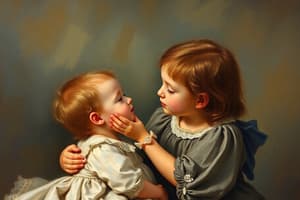Podcast
Questions and Answers
What is attachment?
What is attachment?
An emotional bond with a specific person that is enduring across space and time, usually between infants and caregivers.
What is attachment theory?
What is attachment theory?
Theory based on Bowlby's work that posits that children are biologically predisposed to develop attachments to caregivers as a means of increasing the chances of their own survival.
What does the term secure base refer to?
What does the term secure base refer to?
The idea that the presence of a trusted caregiver provides an infant or toddler with a sense of security that makes it possible for the child to explore the environment.
What is the internal working model of attachment?
What is the internal working model of attachment?
What is the strange situation?
What is the strange situation?
What is secure attachment?
What is secure attachment?
What indicates secure attachment in the strange situation?
What indicates secure attachment in the strange situation?
What is insecure attachment?
What is insecure attachment?
What is insecure/resistant (or ambivalent) attachment?
What is insecure/resistant (or ambivalent) attachment?
What characterizes insecure/resistant attachment in the strange situation?
What characterizes insecure/resistant attachment in the strange situation?
What is insecure/avoidant attachment?
What is insecure/avoidant attachment?
What characterizes insecure/avoidant attachment in a secure situation?
What characterizes insecure/avoidant attachment in a secure situation?
What is disorganized/disoriented attachment?
What is disorganized/disoriented attachment?
What is parental sensitivity?
What is parental sensitivity?
Flashcards are hidden until you start studying
Study Notes
Attachment
- An emotional bond enduring across space and time, primarily between infants and caregivers.
Attachment Theory
- Developed from Bowlby's work; suggests children are biologically inclined to form attachments to enhance survival chances.
Secure Base
- A trusted caregiver's presence offers infants a sense of security, empowering them to explore their environment.
Internal Working Model of Attachment
- A child's mental representation shaped by experiences with caregivers, encompassing self, attachment figures, and relationships.
Strange Situation
- A method created by Mary Ainsworth to evaluate infants' attachment to their primary caregiver through observational procedures.
Secure Attachment
- Characterized by high-quality, unambivalent relationships between infants or young children and their attachment figures.
Secure Attachment in Strange Situation
- Infants show distress during caregiver absence but display happiness upon their return and use caregivers as secure bases for exploration.
Insecure Attachment
- Represents a less positive bond compared to secure attachment, indicating a range of emotional responses to caregivers.
Insecure/Resistant (Ambivalent) Attachment
- Infants exhibit clinginess, preferring to remain close to caregivers over exploring their environment, leading to dependency.
Insecure/Resistant Attachment in Strange Situation
- Infants are highly upset when left alone; upon caregiver return, they are difficult to soothe, showing ambivalence between seeking and resisting comfort.
Insecure/Avoidant Attachment
- Infants display indifference or avoidance towards caregivers, showing a lack of strong emotional connection.
Insecure/Avoidant Attachment in Secure Situation
- Infants appear indifferent before separation and upon reunion, responding similarly to both caregiver and stranger when distressed.
Disorganized/Disoriented Attachment
- Infants lack a consistent coping style during the strange situation, exhibiting confused or contradictory behavior.
Parental Sensitivity
- Crucial for infant attachment security; includes responsive caregiving during distress and engaging in coordinated play to foster connection.
Studying That Suits You
Use AI to generate personalized quizzes and flashcards to suit your learning preferences.




